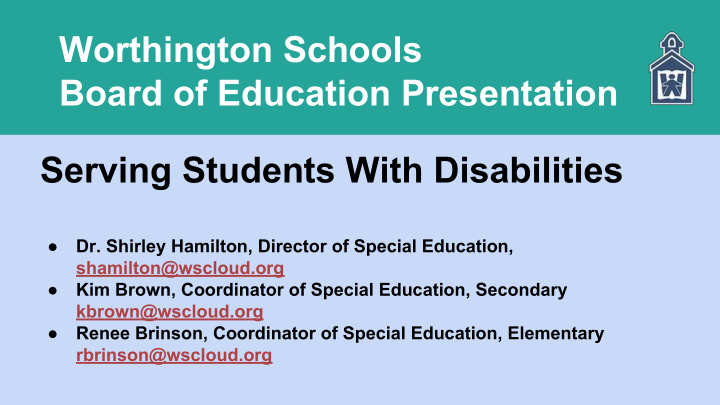



Worthington Schools Board of Education Presentation Serving Students With Disabilities ● Dr. Shirley Hamilton, Director of Special Education, shamilton@wscloud.org ● Kim Brown, Coordinator of Special Education, Secondary kbrown@wscloud.org ● Renee Brinson, Coordinator of Special Education, Elementary rbrinson@wscloud.org
Board of Education Presentation February 22, 2016 Agenda ● Learning Targets, Mission, Vision, Beliefs ● Continuum of Services ● Special Education Structure ● District Programs ○ Daily Living Skills Learning Center (DLSLC) ○ Behavior Learning Center (BLC) ■ Out of District Placements ○ Specialized Learning Center (SLC) ■ Alternate Assessment ■ Extended Standards ○ Structured Communication Learning Center (SCLC) ■ Autism Scholarships ■ Jon Peterson Scholarships ● 5. Funding Model/Successes and Challenges 6. Questions
Learning Targets ● To understand the district’s special education delivery model; ● To understand the various types of special education programming and services; ● To understand the types of students we serve, ● To understand our challenges and celebrate our successes.
Mission The mission of the Special Education Program is to evaluate & identify students with disabilities, and to collaboratively develop and implement an Individualized Education Program within regular education that leads to student growth and independence.
Vision All students with disabilities in Worthington Schools will be educated in an environment of support that promotes growth and independence. Students with disabilities will be empowered with the knowledge, skills and attitudes to develop into independent and productive adults. The individual strengths and needs of each student with a disability will be addressed in collaboration with the student, family, regular and special educators and community.
Beliefs ● The education of students with disabilities is a responsibility shared by parents, regular education teachers, and the community. ● Special Education services are based upon meeting student needs in the least restrictive environment . ● Students with disabilities, to the extent appropriate , should be educated to the extent appropriate, with students who are not disabled . ● A continuum of special education services must be available in order to determine an appropriate educational program through a collaborative team process .
Continuum of Services 1%
Structure ● Special Education Students ○ Total number and percentage Year % ■ 1355 ■ 13.6% 05-06 9.9 Autism .4% 11-12 11.8 ○ Students by grade level 15-16 13.6 Autism 10.5%
Special Education Eligibility Categories Category Percentage Specific Learning Disability 37.30% Other Health Impair/Minor 26.40% Speech and Language Impairment 12.50% Autism 10.50% Emotional Dist (SBH) 3.60% Intellectual Disability 3.50% Mult. Disability 2.60% Developmental Delay 1.80% Orthopedic Impair 1.10% Deaf (Hearing Impaired) 0.44% VIsual Impair 0.22% Other Health Impair/Major 0.07% Traumatic Brain Injury 0.07%
Structure ● SLD and OHI ● Types of Learning Centers ● Staff:Student Ratios ● Locations of Learning Centers
Special Education Structure ● Child Find ● Evaluation Process
Structure IEP process
District Learning Center (6) Daily Living Skills Learning Centers or DLSLC (40) 1.3 Primary } K-6 Brookside (20) 1.2 Intermediate 1 Middle School - McCord (3) 2.5 High School - WKHS (17)
District Learning Center Daily Living Skills Learning Center (DLSLC) ○ Extended Standards ○ Alternate Assessment ○ Transition Services
District Learning Center (5) Behavior Learning Centers or BLC (46) 1 Primary - K-3 Granby (7) 1 Intermediate (3-6) - Wilson Hill (12) 1 Middle School - KMS (10) 2 High School - 1 TWHS (9) 1 WKHS (8)
District Learning Center Behavioral Learning Center (BLC) ○ Behavior Plans ○ Mental Health/Behavior Specialists ○ Out of District Placements
District Learning Center (4.4) Specialized Learning Centers or SLC (55) 1 Primary - K-2 } K-6 Worthington Estates (37) 2 Intermediate 3-6 1.4 Middle School - Worthingway (18) No official High School Program (2 block Classes at TWHS)
District Learning Center Specialized Learning Center (SLC) ○ Alternate Assessment ○ Extended Standards
District Learning Center (11.5) Structured Communications Learning Centers (62) 3 Primary - K-2 - Bluffsview* (6) Slate Hill (6) Worthington Park (6) 4 Intermediate - 3rd-6th - (2) Bluffsview (5\6) Liberty (5) Worthington Hills (4) *(K-6 Continuum - Bluffsview = 17) 1.3 Middle School - KMS (7) 3 High School - TWHS (17)
District Learning Center Structured Communication Learning Center ○ Autism Spectrum ○ Communication and Social Supports ○ Autism Scholarship ○ Jon Peterson Scholarship
Funding Funding Model ○ Weighted Funding Model ○ Based on 6 categories ○ Costs not tracked by category Revenue Sources ○ General funds ○ IDEIA funds ○ Building funds ○ Medicaid reimbursement
Successes and Challenges Successes Challenges ● Student growth- District Report Card ● Staffing ● Graduation Rate ● Growing caseload numbers ● Graduate college and/or career ready ● Time ● Quality staff and programming ● Resources ● Behavior and mental health specialists ● Achievement ● Professional Development ● Transition Services
Questions?
Recommend
More recommend